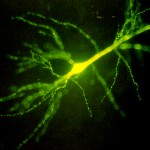by Andrea Navas-Olive and Liset M de la Prida
The CA1 region is traditionally viewed as a single layered structure, but recent evidence has disclosed exquisite cellular heterogeneity at the transcriptional, morphological and functional levels extending along the deep-superficial, proximodistal and dorsoventral axes.
In many occassions to properly interpret experiments it is required to model neuronal activity with enough realism. To examine the effect of heterogeneity in the funcional operation of CA1 , we developed a realist computational model.
LCN-HippoModel Githug: https://github.com/acnavasolive/LCN-HippoModel

The biophysically realistic model of CA1 pyramidal cells uses the Hodgkin-Huxley multi-compartment formalism in the Neuron+Python platform and the morphological database Neuromorpho.org. We adopted genetic algorithms (GA) to identify passive, active and synaptic conductances resulting in experimentaly validy electrophysiological neural behavior. We then used the generated models to explore the functional effect of cellular heterogeneity during theta oscillations, a major hippocampal rhythm associated to ensemble representation during encoding.
This model can be used as a test bank to aid in interpreting experimental findings and to generate new hypotheses on CA1 microcircuit function
See Navas-Olive et al. Nat Commu 11, 2217 (2020)
